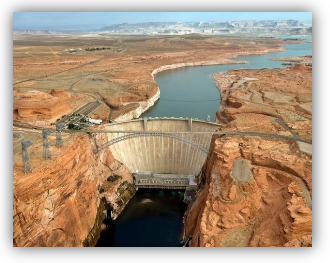Human existence in the West, where millions of people depend on large infrastructure projects for drinking water supply, has always been at odds with natural systems. As changes to the natural environment have caused invasive species to flourish, with rippling effects through ecosystems, the consideration and restoration of natural ecosystems is important.
Students at the University of California, Davis recently came together to discuss the impacts of dams on ecosystems and the challenges of ecosystem restoration in the Colorado River watershed with ecologist Sarah Gaffney.
The Benefits of Riparian Ecosystems
Riparian ecosystems, defined by the life and vegetation that exist near rivers and streams, represent vibrant plant and animal communities that are distinct from other upland ecosystems. Riparian ecosystems provide many services and functions to the environment, including critical habitat for native species of birds and insects.
Dams, which alter the natural system by controlling stream or river flow, can have adverse impacts on riparian ecosystems. For example, some river channels below dams can be reduced in width by 60%, meaning more erosion on the banks of the river and changes to the flow and flooding regimes. Reduced flow and altered flood regimes from dam operations means there is less water to recharge local groundwater systems. Furthermore, the altered flow regime is bad for the plant and animal communities that have depended on the historical flow and flood regime. For example, some plant communities rely on floods for seed dispersal, so the restriction of flow due to the dam can hurt the ability of some species to reproduce.

A Focus on Tamarisk
Ecologist Sarah Gaffney from UC Davis reported on Wednesday, January 31, 2018 to a group of diverse students about the risks associated with the spread of tamarisk in the Colorado River riparian ecosystems. The invasive tamarisk plant species threatens the viability of the original plant community, which consists of cottonwood trees and willow plants. Cottonwood and willow are foundational species within the Colorado River riparian ecosystem that play an important role both as stabilizers of the soil and as habitat for birds and other organisms.
Tamarisk has flourished in this new post-dam regime because it is a plant species that is very tolerant of low water availability and high salinity, both features of the new flow regime. With a longer seed dispersal period than cottonwood and willow, tamarisk has prospered in this setting, threatening the viability of the original plant species. As a result, the riparian ecosystems along the Colorado River have witnessed a decrease in biodiversity; other species depend heavily on the native cottonwood and willow plants and have suffered from their decline.

Tamarisk is not the only threat to Colorado River riparian ecosystems. Russian Olive is another invasive plant species that is problematic for riparian ecosystems in the southwestern United States. Research has shown that the explosion of Russian olive has led to decreases in insect and bird biodiversity.
Plans for Restoration
Gaffney and other scientists recommend restoration of the river’s natural processes in order to restore the health of the original plant communities. Of course, this is challenging to balance with dam operations. Several solutions emerged from the discussion.
Direct removal of tamarisk is an appealing solution because it does not conflict with dam operations. Whether through controlled burning, mechanical removal, or other control methods, many strategies are available for removing tamarisk from the ecosystem. Although removal can help native species return, it may not always be good enough.
Sometimes the removal of invasive species is enough for the native species to recover. However, an important part of the problem is the fact that the river is disconnected from its original flood plain. If changing the flow is not an option, we may want to consider regrading banks along the river.
A third restoration strategy is to alter flow release from the dam to appropriately and consistently flood the landscape like the original flow regimes once did. The deposition of sediments due to flooding might enable native species like cottonwood and willow to reestablish themselves and thrive.
Acknowledging the Complexity
Ecosystems are complex, and humans can easily alter the ecological system in ways that can have rippling effects. Dams have changed the historical flow and flood regime, paving the way for invasive species to enter the landscape. New species threaten the viability of native species and reduce biodiversity in the ecosystem. Although there are several methods to help restore the native landscape, each solution has its pros and cons.
For additional reading, please see:
Kui, Li, John Stella, Patrick Shafroth, Kyle House, and Andrew Wilcox. 2017. "The Long‐ term Legacy of Geomorphic and Riparian Vegetation Feedbacks on the Dammed Bill Williams River, Arizona, USA." Ecohydrology 10.4.
